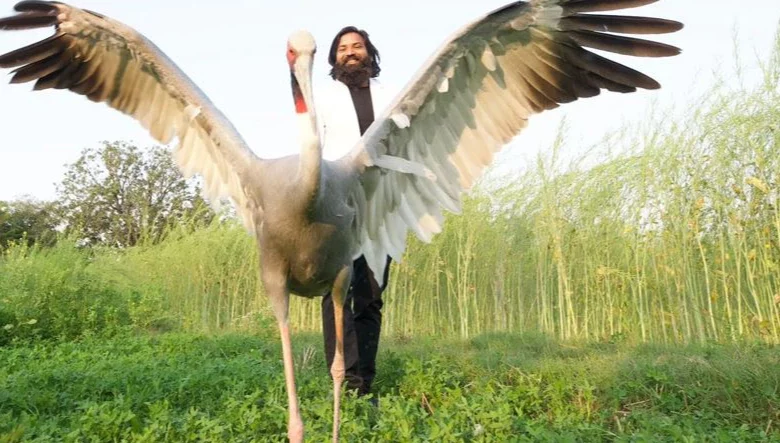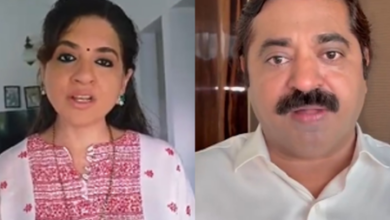
Mobilenews24x7 Bureau
A stitch in time… when Mohammad Arif applied mustard oil paste and tied a splint to the leg of an injured Sarus crane, little did he know that the bird would become family.
There’s no way the farmer could have also imagined, back then, that a year later he would be torn away from the bird (or the bird from him) and booked under various sections of the Wildlife Protection Act. All for attempting to protect wildlife, and unwittingly winning its trust?
There’s no way the farmer could have also imagined, back then, that a year later he would be torn away from the bird (or the bird from him) and booked under various sections of the Wildlife Protection Act. All for attempting to protect wildlife, and unwittingly winning its trust?
“It would stay in the jungle when it wanted. Then, in the evenings it would come to my house and eat with me. I never held it captive,” Arif too had told the press.
The bird was not holed in, not shackled, not shut away. It never flew away despite being kept in the open, media reports have noted.
But now, the Sarus Crane has been placed in a zoo, after it struggled to survive in the wild, and it is reportedly refusing to eat. Arif suggests that the bird should be offered dal, chawal and cooked food, and shown his photograph.
Meanwhile, Arif has been booked under Sections 2, 9, 29, 51 and 52 of the Wildlife Protection Act, 1972 (as amended). He has also been asked to appear before the authorities on 2 April to record his statement.
Sarus Crane falls under Schedule I of the amended act.
A reading of this Act, along with its latest amendment, indicates that, if convicted, Arif can be penalised with imprisonment for a term of three to seven years, and also with fine which shall not be less than twenty-five thousand rupees.
And what are the offences Arif is alleged to have been guilty of?
Hunting, which, in its definition includes capturing, coursing, snaring, trapping, driving or baiting
Destruction, etc., in a sanctuary prohibited without a permit which includes removal of wild life from a sanctuary or destruction or damage or diversion of the habitat of any wild animal by any act whatsoever, except under a permit granted by the Chief Wild Life Warden
Attempts and abatement, in the contravention of, any of the provisions of this Act or of any rule or order made thereunder
Experts Say
However, experts have recalled the video in which the bird could be seen flying, out of its own volition, behind Arif’s bike – a video that went viral as testament to the possibility of an unyielding human-animal bond.
They have thus questioned how despite the legal-speak, could Arif really be accused of holding the bird captive?
Sinha further said that the video, in fact, reminded him of the beautiful visual of Prime Minister Narendra Modi feeding a pea fowl (which too is another species listed under Schedule I).
“Now these kind of instances exist everywhere. There are people who live near forests, and elephants and other wild animals visit their gardens. So if those who are staying there don’t have a problem, and they are not hurting them, why should anyone else have a problem?” he added.
“They are mostly found in farms and paddy fields. Just because an animal has been listed in Schedule I, it does not mean that it’s a forest dwelling animal.”
For instance, a pea fowl can be found everywhere, from the side of a road to homes occupied by the human civilisation.
“The natural habitat of the sarus crane in India is agricultural fields, and they prefer that and they are living along with people,” the ecologist added.
Other experts have also pointed out that there is a scientific explanation for the relationship that the crane had forged with Arif.
“Such birds show a high preponderance to imprint on humans when they are kept in close proximity as young birds, or before they have found mates of their own,” K.S. Gopi Sundar, the global co-chair of the IUCN Stork told IANS.
“Once such imprinting happens, it is not a good idea to release it into the wild since that bird will seek human companionship frequently.”
What About Now?
According to Sundar, moving the bird out of its own human’s protection, can put it in harm’s way.
“Since other humans may not have the same willingness to include the crane into their lives. Additionally, cranes coming into human settlements in places like Uttar Pradesh will face more dangerous threats like dogs… electricity wires, and so on.”
Besides, Sinha expressed concern over the manner in which the authorities have taken the crane out of its habitat, seemingly ‘captured’ it; then transferred the animal to some other place; then relocated it to a zoo.
“Hunting does not just entail killing an animal, it is also used to refer to capturing of an animal,” he explained.
“And the wildlife protection act is very clear, to hunt/capture an animal (under section 11), even a forest-ranger first requires permission from chief wild life warden. And to grant permission, the warden has to be satisfied that the animal has become dangerous to human life or is disabled or diseased beyond recovery. In this case none of the above appear to apply. ”
(With inputs from IANS, India Today, Delhi Times, The Indian Express, Thequint )






